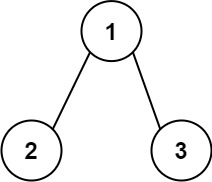Table of Contents
Problem Statement
Sum Root to Leaf Numbers LeetCode Solution says – You are given the root of a binary tree containing digits from 0 to 9 only.
Each root-to-leaf path in the tree represents a number.
- For example, the root-to-leaf path
1 -> 2 -> 3represents the number123.
Return the total sum of all root-to-leaf numbers. Test cases are generated so that the answer will fit in a 32-bit integer.
A leaf node is a node with no children.

Input: root = [1,2,3] Output: 25 Explanation: The root-to-leaf path 1->2 represents the number 12. The root-to-leaf path 1->3 represents the number 13. Therefore, sum = 12 + 13 = 25.

Input: root = [4,9,0,5,1] Output: 1026 Explanation: The root-to-leaf path 4->9->5 represents the number 495. The root-to-leaf path 4->9->1 represents the number 491. The root-to-leaf path 4->0 represents the number 40. Therefore, sum = 495 + 491 + 40 = 1026.
Explanation
We recursively go to each node and check if it is null or not
a- If it is a null node, then we skip it and move to the next
b- If it is not a null node, we multiply the current by 10, and add the node value
We repeat the same procedure for all the nodes present, to get the final answer and return it.
Code
Java Solution:
class Solution {
public int sumNumbers(TreeNode root) {
return solve(root, 0);
}
int solve(TreeNode root, int curr){
if(root == null){
return 0;
}
curr = curr*10 + root.val;
if(root.left == null && root.right == null){
//leaf node
return curr ;
}
return solve(root.left, curr) + solve(root.right, curr);
}
}
C++ Solution
class Solution {
public:
void solve(TreeNode* root, int ans, int &fans)
{
if(!root)
return;
if(!root->left && !root->right)
{
ans = ans *10 + root->val;
fans +=ans;
return;
}
ans = ans *10 + root->val;
solve(root->left, ans, fans);
solve(root->right, ans,fans);
}
int sumNumbers(TreeNode* root)
{
int ans =0;
int fans = 0;
solve(root, ans, fans);
return fans;
}
};Complexity Analysis of Sum Root to Leaf Numbers Leetcode Solution:
Time complexity O(N) where N is number of Nodes
Space complexity O(H) where H is the height of the tree